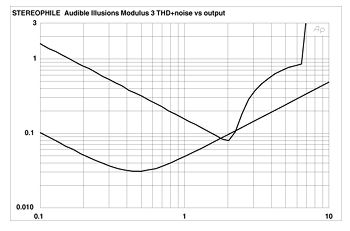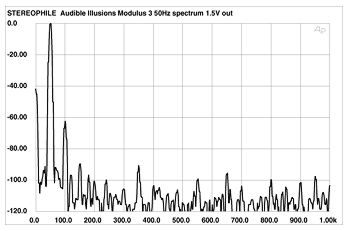| Columns Retired Columns & Blogs |
Audible Illusions Modulus 3A preamplifier Measurements part 2
The change in THD+noise with output level using a 1kHz signal is shown in fig.4. Both the phono (top) and line-stage (bottom) performances are shown. The distortion and crosstalk measurements of figs.2 and 3 for the line-stage were taken at an input of 100mV, which results in a distortion just slightly above the minimum shown in this figure. The same measurements for the phono stage were taken at an input of 4mV, which resulted in an output very close to the minimum on the phono stage curve in fig.4 and minimized the effects of noise on the measurements.

Fig.4 Audible Illusions Modulus 3A, distortion (%) vs output voltage into 100k ohms of phono stage (top) and line stage.
The Audible Illusions phono stage would accept an (unequalized) input of 13.4mV at 1kHz, 141mV at 20kHz, and 0.48mV at 20Hz at a THD+noise level of 1%—very respectable figures for a moving-coil stage. The variations with frequency are simply the result of the phono equalization characteristics (RIAA); there's considerably less bass energy engraved in the grooves than high-frequency energy.
Finally, fig.5 shows the 3's output spectrum reproducing a line-level 50Hz input at a high output of 5V into 100k ohms. The largest artifact is the second harmonic, at -51.7dB or about 0.25%. At a more typical output of 1.5V (not shown), the second harmonic decreases to -62.2dB (about 0.08%) and the remaining artifacts drop below -90dB (0.003%).

Fig.5 Audible Illusions Modulus 3A, spectrum of 50Hz sinewave, DC-1kHz, at 5V into 100k ohms (linear frequency scale). Note that the second harmonic at 100Hz is the highest in level, at -51.7dB (about 0.25%).
Our measurements on the Modulus 3 don't agree down the line with the measurements AI included with our sample (for logistical reasons, this was not the same sample auditioned by MF). Nevertheless, the only notable discrepancy involves the line-level frequency response, which we measured as rolling off above 10kHz but which Audible Illusions shows as only 0.7dB down at 100kHz.
In my experience, the latter would be excellent performance for any preamp, and very unusual for a tube design. Our results aren't at all unusual for a well-designed tube preamp—which is exactly what the Modulus 3 appears to be. Only the slightly high output impedance suggests that some care should be taken in matching it with a power amplifier, for which I would recommend a minimum of 20k ohms input impedance.—Thomas J. Norton
- Log in or register to post comments




































